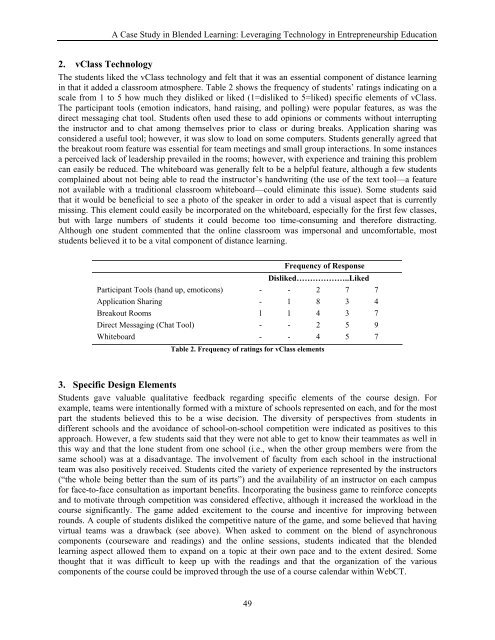Elements of Quality Online Education cation
Elements of Quality Online Education cation
Elements of Quality Online Education cation
You also want an ePaper? Increase the reach of your titles
YUMPU automatically turns print PDFs into web optimized ePapers that Google loves.
A Case Study in Blended Learning: Leveraging Technology in Entrepreneurship <strong>Edu<strong>cation</strong></strong>2. vClass TechnologyThe students liked the vClass technology and felt that it was an essential component <strong>of</strong> distance learningin that it added a classroom atmosphere. Table 2 shows the frequency <strong>of</strong> students’ ratings indicating on ascale from 1 to 5 how much they disliked or liked (1=disliked to 5=liked) specific elements <strong>of</strong> vClass.The participant tools (emotion indicators, hand raising, and polling) were popular features, as was thedirect messaging chat tool. Students <strong>of</strong>ten used these to add opinions or comments without interruptingthe instructor and to chat among themselves prior to class or during breaks. Appli<strong>cation</strong> sharing wasconsidered a useful tool; however, it was slow to load on some computers. Students generally agreed thatthe breakout room feature was essential for team meetings and small group interactions. In some instancesa perceived lack <strong>of</strong> leadership prevailed in the rooms; however, with experience and training this problemcan easily be reduced. The whiteboard was generally felt to be a helpful feature, although a few studentscomplained about not being able to read the instructor’s handwriting (the use <strong>of</strong> the text tool—a featurenot available with a traditional classroom whiteboard—could eliminate this issue). Some students saidthat it would be beneficial to see a photo <strong>of</strong> the speaker in order to add a visual aspect that is currentlymissing. This element could easily be incorporated on the whiteboard, especially for the first few classes,but with large numbers <strong>of</strong> students it could become too time-consuming and therefore distracting.Although one student commented that the online classroom was impersonal and uncomfortable, moststudents believed it to be a vital component <strong>of</strong> distance learning.Frequency <strong>of</strong> ResponseDisliked………………..LikedParticipant Tools (hand up, emoticons) - - 2 7 7Appli<strong>cation</strong> Sharing - 1 8 3 4Breakout Rooms 1 1 4 3 7Direct Messaging (Chat Tool) - - 2 5 9Whiteboard - - 4 5 7Table 2. Frequency <strong>of</strong> ratings for vClass elements3. Specific Design <strong>Elements</strong>Students gave valuable qualitative feedback regarding specific elements <strong>of</strong> the course design. Forexample, teams were intentionally formed with a mixture <strong>of</strong> schools represented on each, and for the mostpart the students believed this to be a wise decision. The diversity <strong>of</strong> perspectives from students indifferent schools and the avoidance <strong>of</strong> school-on-school competition were indicated as positives to thisapproach. However, a few students said that they were not able to get to know their teammates as well inthis way and that the lone student from one school (i.e., when the other group members were from thesame school) was at a disadvantage. The involvement <strong>of</strong> faculty from each school in the instructionalteam was also positively received. Students cited the variety <strong>of</strong> experience represented by the instructors(“the whole being better than the sum <strong>of</strong> its parts”) and the availability <strong>of</strong> an instructor on each campusfor face-to-face consultation as important benefits. Incorporating the business game to reinforce conceptsand to motivate through competition was considered effective, although it increased the workload in thecourse significantly. The game added excitement to the course and incentive for improving betweenrounds. A couple <strong>of</strong> students disliked the competitive nature <strong>of</strong> the game, and some believed that havingvirtual teams was a drawback (see above). When asked to comment on the blend <strong>of</strong> asynchronouscomponents (courseware and readings) and the online sessions, students indicated that the blendedlearning aspect allowed them to expand on a topic at their own pace and to the extent desired. Somethought that it was difficult to keep up with the readings and that the organization <strong>of</strong> the variouscomponents <strong>of</strong> the course could be improved through the use <strong>of</strong> a course calendar within WebCT.49
















